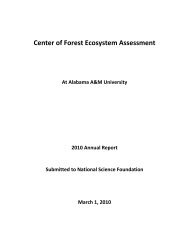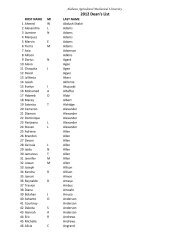2012 CREST Annual Report - Alabama A&M University
2012 CREST Annual Report - Alabama A&M University
2012 CREST Annual Report - Alabama A&M University
- No tags were found...
You also want an ePaper? Increase the reach of your titles
YUMPU automatically turns print PDFs into web optimized ePapers that Google loves.
Figure 5. Phylogenetic tree of the five red oak species based on cluster analysis of the SSR primers from 200 samplesand six locations in our study.Southern Red OakShumard OakNorthern Red OakBlack OakScarlet Oak1.21.11.00.90.80.70.60.50.40.30.20.10.0Average Distance Between ClustersIdentification of pure species vs. hybrids is an important attribute for understanding the populationdynamics of oaks and for the economic reasons as well. Therefore, categorization of genetic diversitywithin and among the oak species with the use of molecular markers may facilitate unambiguousidentification of trees. A majority of the SSRs exhibited cross-species amplification and thus have thepotential for use in detecting molecular phylogeography of the red oaks. These markers will be used tohelp in establishing the genetic diversity of Quercus spp. in the Southern Cumberland Plateau.OTHER RESEARCH FINDINGS:In addition to the research components described in detail in the report, we have been working on thefollowing projects related to the CFEA research objectives.1. Control of non-native invasive forest tree and shrub species without the use of synthetic chemicals (L.Dimov and J. Williams).A more environmentally friendly and cost effective method of controlling invasive species may be the useof high intensity fire. We tested this method with three non-native and highly invasive species: royalpaulownia (Paulownia tomentosa), Chinese privet (Ligustrum sinense), and bush honeysuckle (Loniceraspp.).
















